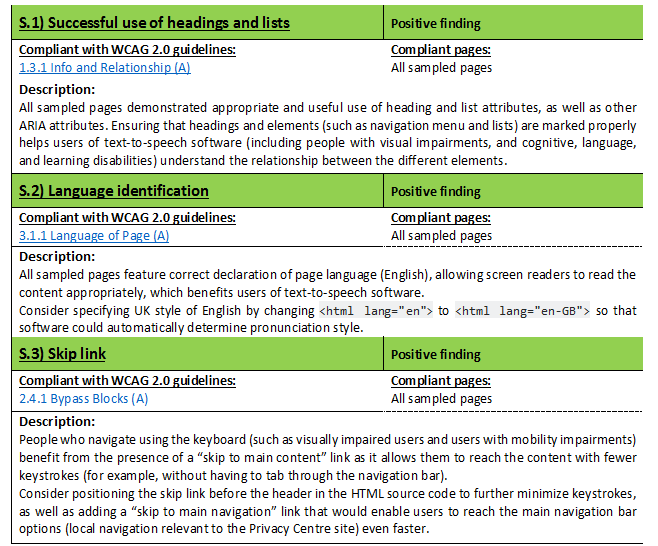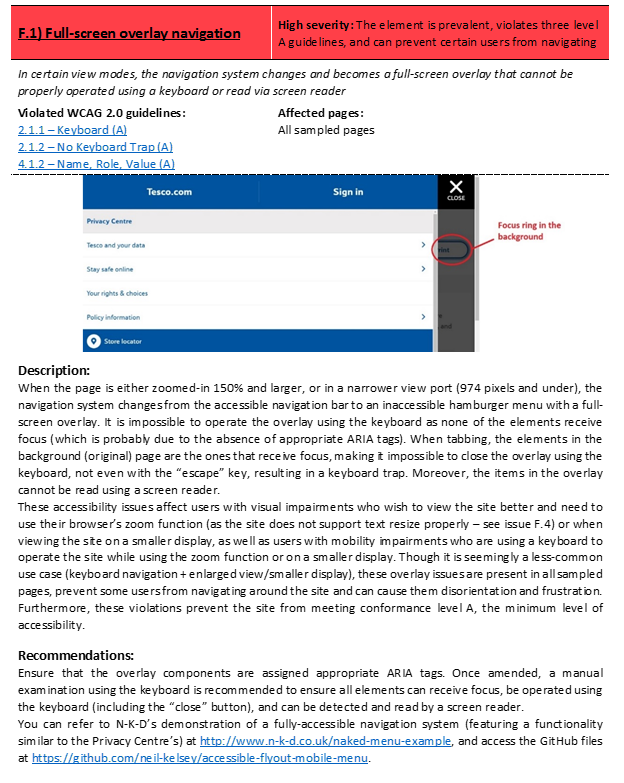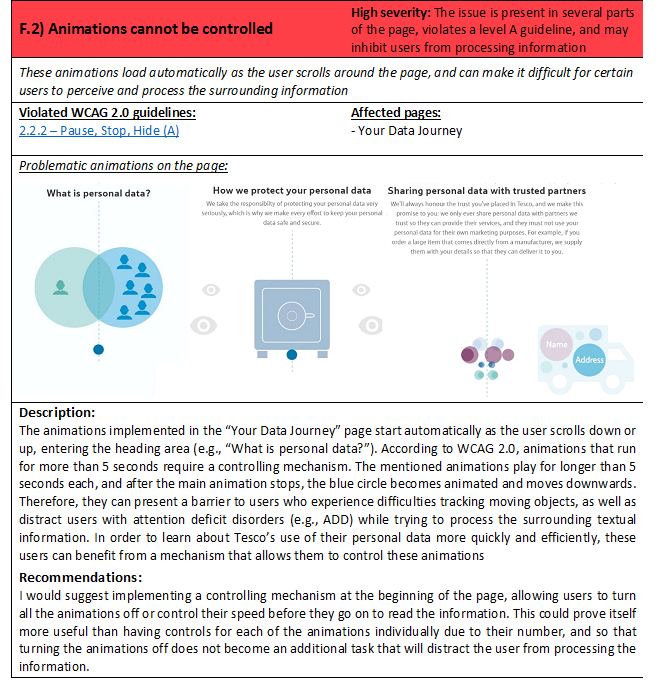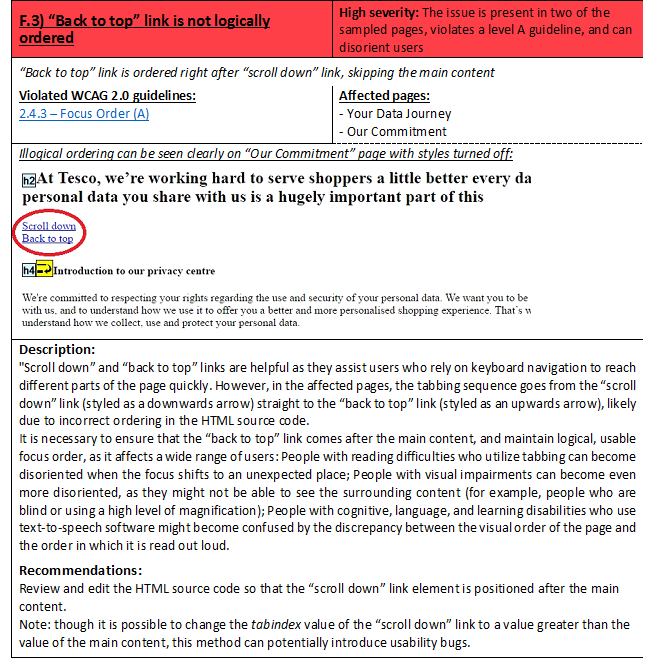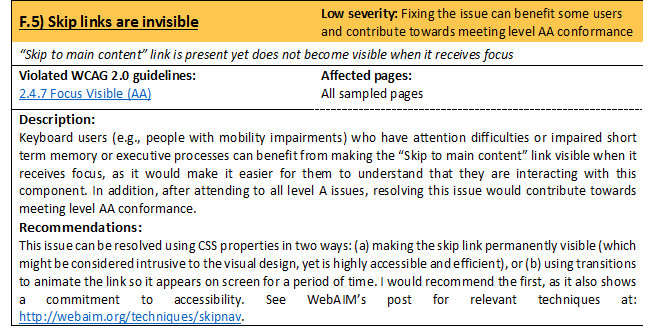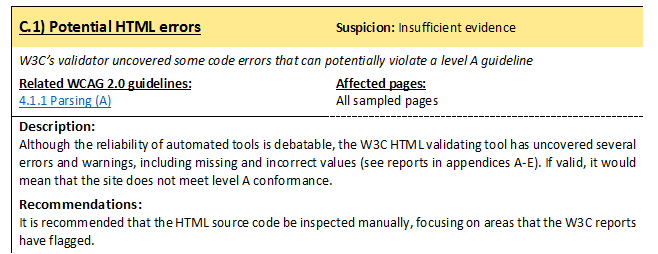This project was submitted as part of the Inclusive module of the HCI Design MSc and awarded a Distinction.
Summary: I conducted an expert accessibility audit of Tesco’s Privacy Centre website according to the WCAG 2.0 guidelines. The audit concentrated on level A and level AA guidelines, and consisted of manual examination of all page elements, input from automated tools (WAVE Chrome extension and W3C’s HTML validator), as well as different interaction styles (using NVDA screen reader and operating using keyboard only) and view modes (100%, zoomed-in at 150%, desaturated, no styles) in order to examine how users with different impairments experience the Privacy Centre website.
The audit concluded that the website does not meet level A conformance due to several violations of different severity levels. Among the more severe violations were elements that can actively:
- Disorient or frustrate users, including illogically ordered skip links;
- Make information processing difficult (e.g., animations that cannot be controlled);
- Prevent users from navigating around the site, such as a full-screen overlay navigation menu that cannot be operated using a keyboard nor read by the screen reader.
BACKGROUND
Ensuring that a website is accessible means that people with various disabilities can perceive, understand, navigate, and interact with it. Accessibility encompasses all disabilities that affect access and interaction, including visual (e.g., blindness), auditory (e.g., deafness), and mobility (e.g., paralysis), as well as cognitive and neurological impairments. There are over 11 million people in the UK with a limiting impairment or disability with an estimated spending power of £120 billion. Some of these individuals require that a website conform to certain accessibility standards, in order for them to access and understand its content efficiently.
The Web Content Accessibility Guidelines (WCAG 2.0) are one of the most adopted and internationally recognized standards for creating accessible web content. These guidelines are organized into three levels of conformance: level A (“must have”, the most basic web accessibility features), level AA (“should have”, targets the most common barriers for disabled users), and level AAA (“may have”, the highest level of web accessibility).
METHOD
A user journey was created in order to determine the scope of the audit. The journey aimed to reflect how an average user might navigate naturally around the Privacy Centre website, seeking information about how his personal data is being used:
Upon arrival at the Privacy Centre homepage, the user notices the “Tesco and your data” element, finds the supporting text as relevant to his goal, and clicks the “Learn more” button. He arrives at the new page and finds more links, and decides to learn more about Tesco’s commitment. He feels that he needs more specific information about how his information is being used, goes back to the previous page, and decides that “Your data journey” could provide more answers. After reading the content on the page, the user wishes for more detailed information, and follows the link to the “Privacy and cookies policy” page.
The audit therefore concentrated on the following five pages:
Several manual inspections of the sampled pages were conducted on a 15.6” Lenovo G510 laptop running Windows 8.1, using Google Chrome browser (v56.0.2924.87). All pages were inspected against WCAG 2.0 guidelines at levels A and AA.
The audit utilized a number of tools and software for different purposes: NVDA screen reader (v2017.1) was used to examine how the pages were read out loud by a popular text-to-speech software; The Chrome extension WAVE Evaluation Tool (v1.0.5) was used as a preliminary means of automated inspection, and to view the page desaturated, and with styles turned off; An automated inspection of the HTML source code was run using the W3C Markup Validation Service.
Each page was viewed and interacted with in several modes: “normal” view at 100%, 100% with styles turned off/desaturated, and zoomed-in at 150% since the website did not support automatic font resize using Chrome’s accessibility features. Each page was additionally examined by using the NVDA screen reader and the keyboard as input device, to gain insight into how users with visual and mobility impairments experience the site.
Finally, findings from all pages were aggregated and their severity was assessed based on the following criteria:
- Violations of level A guidelines (the minimum level of accessibility that the site must meet) were rated more severe than violations of level AA guideline (the desired level of accessibility).
- Violations that can actively inhibit users from performing basic actions (such as navigation) or result in confusion and disorientation received higher severity rating.
- Violations that are present on several pages, or several times on the same page, were rated more severe.
The following describes some of the uncovered accessibility failures, including the respective violated guidelines and recommendations for action. In addition, suspicious findings that arose from the automated HTML validator and require further investigation are outlined, as well as some positive findings that demonstrate good accessibility practices and should be kept in future iterations.
FINDINGS
ACCESSIBILITY SUCCESSES
ACCESSIBILITY FAILURES
CONCERNS THAT REQUIRE FURTHER INVESTIGATION
CONCLUSIONS
While the site satisfies several level A guidelines (for example, by providing a skip link, and by using headings successfully), the audit has uncovered some elements that fail to meet other level A guidelines, preventing the site from achieving minimum level of accessibility. The most severe violations (F.1, F.2, and F.3) can actively affect a wide range of users with impairments, prevent them from interacting with the site, disorient them, or diminish their ability to learn about how their personal data is being used by Tesco.
Moving forward, the following steps are recommended:
- Resolving the aforementioned accessibility issues.
- Carefully reviewing the code, fixing or disproving the concerns raised by the W3C validator.
- Conducting a second audit to ensure that all level A guidelines have been successfully met, and to review the site against level AA guidelines.
- Once level A compliance is confirmed, it is strongly advised that further efforts are invested into meeting level AA, which targets some of the most common barriers faced by users with impairments. These efforts should include resolving issues F.4 and F.5.
- After level AA violations are resolved, a third audit should be conducted to confirm level AA conformance.
By following these steps and ensuring that accessibility requirements are kept as a priority in future iterations, Tesco Privacy Centre can become more usable and accommodating for a wider range of users. These users will benefit from the ability to access, process, and understand the important information presented on the site, and hopefully gain more trust in the Tesco brand, as well as appreciation for acknowledging and addressing their needs.

